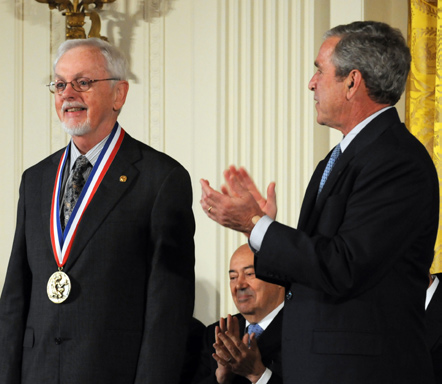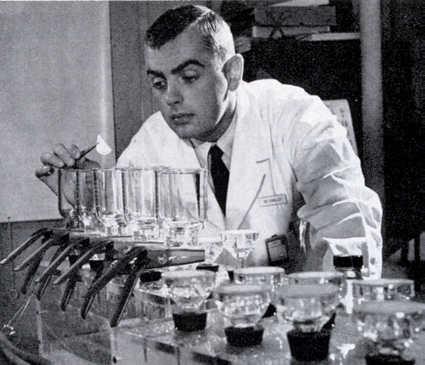 |
Dr. Bert O’Malley (l), former NCI section chief and a long-term grantee of NIDDK and NICHD who recently won a National Medal of Science, is applauded by President Bush.
Photo: Ryan K. Morris/NSTMF |
Dr. Bert O’Malley, former NCI section chief and a long-term grantee of NIDDK and NICHD, has won a National Medal of Science for his outstanding contributions to knowledge
in the biological sciences. On Sept. 29, President Bush presented the award recognizing
“his pioneering work on the molecular mechanisms of steroid hormone action and hormone receptors and coactivators, which has had a profound impact on our knowledge of steroid hormones in normal development and in diseases, including cancer.”
O’Malley, chair of Baylor College of Medicine’s department of molecular and cellular biology, is the first scientist in the field of molecular endocrinology
to receive the medal, considered the highest national honor in biological sciences.
“Bert O’Malley has creatively and persistently wrestled with some of the biggest questions in biology. His discoveries have not only clarified how hormones work, a stubborn mystery several decades ago, but they have also illuminated the causes and treatment of diseases as diverse as cancer, diabetes and reproductive disorders,” said NIH director Dr. Elias Zerhouni.
In 1965, O’Malley joined NCI as a clinical associate.
Two years later, he was appointed head of the molecular biology section in NCI’s Endocrine Branch. There he developed a model system—the chick oviduct—to study the effects of the steroid hormones estrogen and progesterone in this highly
responsive tissue. Those studies led to an unexpected
observation of the hormones’ effect on activities inside the cell nucleus.
From 1969 to 1973, he directed the Reproductive Biology Center at Vanderbilt University School of Medicine. In 1973, he joined Baylor University’s
School of Medicine as chair of the cell biology department and director of the Baylor Center for Reproductive Biology. Today the Baylor Center is part of NICHD’s Specialized Cooperative Centers Program in Reproduction and Infertility Research.
 |
| O’Malley at work at NIH in 1967 |
Much of O’Malley’s early work focused on the steroid
hormones—glucocorticoids, mineralocorticoids,
androgens, estrogens and progestagens—that regulate reproduction and basic metabolism. He used the tools of physiology and biochemistry to study the hormones’ role in reproduction and developmental diseases and was one of the first to apply new methods as they were introduced.
“The challenges in those days were immense, considering
that scientists had not yet found the receptors for these hormones nor had they yet discovered that they all belonged to a common family,” said Dr. Ronald Margolis, NIDDK senior advisor for molecular endocrinology.
In the 1980s, evidence was growing that receptors
for steroid hormones had unique structural properties and belonged to a common family of receptors. Instead of attaching to receptors on the cell surface, these hormones linked up with receptors in the cell and its nucleus and acted as transcription factors to change the expression of genes. After the first nuclear receptor was cloned, scientists went on to find 49 more, including those for steroid hormones, thyroid hormones, certain vitamins and receptors for hormones that were still unknown. These “orphan receptors” also turned out to have profound effects on cells.
“Bert was one of the first to create an in vitro transcription
assay, or a test tube system, that could recapitulate what happened inside a cell to study the changes in gene expression. His assay stimulated
much research that led to an even greater understanding of hormone action because scientists
could use the method to study their favorite hormone and receptor,” said Margolis.
“O’Malley’s discoveries led to the development of selective steroid receptor modulators, a class of new drugs that can selectively target one tissue while leaving other tissues unaffected. His findings
also laid the groundwork for the development
of two important drugs: a progestin compound
that prevents preterm birth in certain cases and raloxifene, which prevents osteoporosis,”
added Dr. Louis De Paolo, chief of NICHD’s Reproductive Sciences Branch.
In 1995, O’Malley and others discovered a group of nuclear receptor coregulators, molecules in the nucleus that control how nuclear receptors work. Coregulators, he found, helped turn on and off transcription factors such as nuclear receptors, which in turn helped to orchestrate the expression
of many other genes. Probing deeper, he identified a subset of coregulators, called coactivators,
which are required for hormone action. Other researchers soon found corepressors, which silence transcription.
“Hormones control almost all cellular physiology,”
O’Malley explains. “Receptors for steroid hormones,
the most important class of hormones, are activated by the hormone, then they go into the cell’s DNA and search out and find the target
genes to be turned on or off. In the final step, they recruit complexes of coregulators, including
coactivators, that perform all the functions to turn the genes on. In a sense, these coactivators are master genes because they can activate different
transcription factors at the same time, so you get a coordinated physiologic outcome.”
Forging ahead, O’Malley and colleagues came to a stunning conclusion: nuclear receptor coregulators
control physiologic processes as basic as cell growth, metabolism, inflammation and reproduction.
And if defective, these “little molecules with big goals” can lead to disease. “When the activities of these master genes are compromised,
cellular processes can quickly deteriorate,” says O’Malley. In overdrive, some can spur the uncontrolled growth of cancer cells.
For example, the steroid receptor coactivator SRC-3 fuels the growth of most prostate tumors and 65 percent of breast tumors. Another coactivator,
SRC-2, controls sugar production by the liver. When it is defective, a form of glycogen storage disease develops. Other SRCs influence fat cells, energy balance and carbohydrate metabolism.
O’Malley is principal investigator of the Nuclear
Receptor Signaling Atlas (www.nursa.org/), a trans-NIH consortium that provides a central
source of information on hormones, nuclear receptors and coregulators. To date, 300 coregulators
for 49 nuclear receptors have been found and 165 coregulators have been linked to disease.
“O’Malley’s prodigious career is a tribute to the importance of basic research,” says Dr. Griffin Rodgers, NIDDK director. “His research revolutionized
the understanding of hormone action and the molecular regulation of processes as basic as metabolism and reproduction. By studying
the mechanisms of hormone action, he unexpectedly
found molecular pathways that lead to a number of diseases. Some therapies that capitalize
on his findings are already in clinical trials.”
“Basic research is our fountain of knowledge,” says O’Malley. “I always felt that if I knew how things work in normal cells, I’d have much better insight how to fix them when they go wrong in disease. If you open the hood of a car, you don’t know how to fix it if you don’t know how the motor works.” 